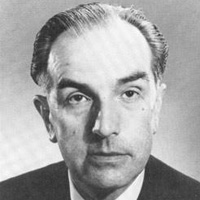Naming of Parts by Henry Reed: Summary and Analysis
Naming of Parts written in 1942 by an English poet Henry Reed is a war poem written during the Second World War. It has five stanzas and is a fine lyric poem where the new recruit is being taught to operate a rifle, but at the same time is being distracted by the outer beauty of the springtime. The two distinct speakers in the poem; one the strict instructor and the other new sensitive recruit, go side by side presenting their views on war and normal life.

Henry Reed (1914-1986)
The first speaker speaks within about the first three and a half lines of each stanza and the second speaker speaks in the remaining lines of the stanza. The first speaker is too much concerned about the war and teaching the proper operation of the rifle and the second speaker is less worried about the war and much attracted by the normal life and the pleasures of the spring time.
The opening of the poem is spoken by the instructor who clearly says that the particular day is for the naming of the parts of the rifle. But meanwhile, the second speaker is fascinated by the Japonica flower glittering like a coral who cannot pay full attention to the first speaker. The instructor is teaching about the swivels of rifle and telling them that they will get their own rifle later on. The second speaker at that moment turns his attention to the branches of the tree which are silently holding their gracing beauty. The second speaker juxtaposes his restless mind to the silent branch. The instructor is now telling about the safety catch of the rifle and strictly warning them not to use their fingers instead tell them to use their thumb. The second speaker is again comparing human life to the fragile and unpredictable life of flowers. Though being so fragile to the outer world the flowers are not using any safety mechanism. He is surprised by the fact how the flowers simply exist in the nature without any sense of violence. The first speaker is now focusing on the bolt and breech. He uses the military term for releasing the bolt as ‘easing the spring’ which takes the second speaker to the bees and their pollination process taking outside in the nature. The bees and the pollination process forces the speaker to suggest a sexual connation to the meaning of the ‘easing the spring.’ The movement of the bolt and breech ‘forward and backward’ with great speed directly suggests the sexual act that is being suppressed in the newly recruit. The rifle ‘cocking-piece’ refers to the fitting symbol of sexual tension, and the ‘release’ he and his fellow soldiers are being denied. The rifle's ‘point of balance’ figuratively suggests the present situation of the young soldiers how they have been living in balance out of imbalance.
Henry Reed projects two speakers with the main poetic device of imagery and wordplay to cater the connotative meaning. The world of war and the world of nature is juxtaposed with the imagery of Japonica plant shining like a coral and the rifle imagery in the first stanza. The imagery of missing ‘piling swivel’ is contrasted with the imagery of tree branches that hold the trees in an eloquent manner and in great silence. The ‘easing the spring’, ‘assaulting and fumbling the flowers’, ‘rapidly forward and backward’, imagery figuratively suggest the sexual connotations. The bees are shown as the active predators and the flowers as the passive victim in the nature and they are suggested as the sexual symbols.
Reed is against the war that can be vividly seen in this poem when he shows the second speaker who is not concerned with the war and the instructions given by the senior. Despite the beautiful season of birth and renewal, the spring season, the soldiers are forced to unproductive act of war. The flower Japonica is noteworthy here as it is primarily found in Japan, one of the powerful enemy of England, and its presence in the war scene shows that nature transcends political and natural boundaries.
